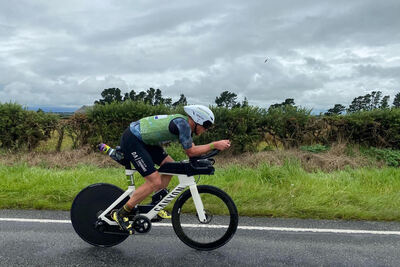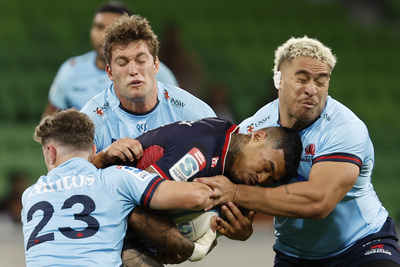Head trauma in sport is more commonly associated with contact sports like rugby and American Football, where players are throwing their bodies on the line, often head first.
Athletes from endurance sports backgrounds aren’t immune to head injuries though, whether that’s caused by a stray elbow during a swim race or, more commonly, due to a bike crash. In fact, cycling accidents have been cited as one of the most common causes of concussion.
I’ve taken a look at how you should respond to suffering a head injury and outlined the steps to ensure a safe return to your sport…
What is a concussion?
Anyone who’s suffered a head injury will recognise the heavy fog and banging headache that follows, but what actually constitutes a concussion?
A concussion is a form of traumatic brain injury (TBI) and needs to be taken seriously. It’s caused by the rapid acceleration and deceleration of the brain during a collision. Usually, the impact involves a bump or jolt to the head, although a hit to the body with enough force could potentially have equally harmful effects on the brain.
During the rapid change in speed experienced during a head injury, the brain elongates and then deforms as it collides with the inside of the skull, with the potential to cause stretching and damage to brain cells. This damage can lead to disruption of communication along nerves and causes the release of chemicals that can cause further damage.
It can be as unpleasant as it sounds, so it’s worth versing yourself in the early signs of a concussion to ensure you rest and avoid longer term issues…
What are the signs of a concussion?
If you suffer a head injury, concussion symptoms may present as:
- headache
- loss of consciousness
- nausea and vomiting
- difficulty concentrating
- personality changes
Symptoms can come on immediately or take hours, days, or even weeks to months to develop.

Pro cyclist Lizzy Banks’ experience of concussion serves as a warning to fellow athletes. Lizzy suffered a crash whilst racing the Strade Bianche, she finished the remaining 100km of the race before tending to her bleeding wounds. She completely forgot that she’d injured her head until later, when her team director called to check on her after seeing the damage to her helmet. Lizzy insisted that she felt fine, initially…
“In hindsight, I was not okay,” she told Velo News.
“The day that I travelled home I couldn't read the departure board at the train station. It was so bright, and the numbers were so blurry. But I was tired. And I wasn't thinking straight. There are reasons why it makes sense that these things aren't quite right. I'd had a horrendous journey, I couldn't get any food, I was exhausted, the race had been ridiculously hard, I’d crashed, and I was tired.”
On reaching home, it dawned on Lizzy that the symptoms she was suffering from were more than post-race fatigue. “When I got home, I was bumping into things, dropping things, and obviously in your own house that’s not really normal.”
Lizzy thankfully recovered, but her story emphasises the fact that one of the most important things you can do after sustaining a head injury is to make sure someone is with you for the immediate recovery period of ~24 hours. It can be difficult to think coherently and, as such, can affect your decision-making, so having someone with you is helpful in order to assess your symptoms.
It's important to then rest and observe your symptoms. If symptoms persist for 10-14 days, or if you're concerned that there's an issue, seek medical help as various neurological tests and brain imaging may be required to determine the severity of the injury.
In mild cases, treatment may include painkillers and rest to allow the brain to recover. The National Health Service in the UK recommends using ice packs on the head initially to try to reduce swelling. If pain relief is required in the first 24 hours, paracetamol should be the preference over ibuprofen or aspirin because the latter are associated with an increased risk of bleeding.
In more severe cases, hospital admission may be required for a period of observation with the potential for more complex treatment offered. The NHS suggests visiting a hospital if you’ve:
- been knocked out
- vomited since the injury
- suffered a headache that doesn’t go away with painkillers
- endured a change in behaviour (e.g. feeling more irritable)
- experienced problems with memory
- got a blood clotting disorder (like haemophilia) or you take medicine to thin your blood
- had brain surgery in the past
What are the dangers of a second head injury?
80-90% of sport-related concussion symptoms typically resolve within 7-10 days, although they may persist for longer if you've suffered multiple head injuries.
A study by the National Institute of Neurological Disorders and Stroke found that a second head injury closely following the first can lead to much more severe and sometimes permanent brain damage.
Their research shows that significant long-term cognitive deficits begin to be seen after only three minor TBI's, with cognitive decline being observed with each subsequent concussion. The study has also shown that having just one moderate-severe TBI can cause long-term damage to brain function, including memory.
Many of us will have experienced numerous crashes, collisions and falls, so it’s worth bearing in mind that multiple ‘minor’ head injuries can cause cognitive impairment in later life. Cognitive impairment refers to the effects upon your memory, attention, and processing speed. The full extent of this study is still ongoing.
The continued research in this area has led to a change in attitude towards head injuries over the last decade. Driven primarily by team sports such as rugby and soccer where concussions have ended athletes' careers, the sporting world has grown accustomed to concussions, when to suspect them and how serious they can be in order to limit the risks of longer-term health implications.

As a result, the decisions at the pro level of rugby and soccer have been taken away from athletes and put in the hands of independent doctors, with a focus on the health and safety of the competitor coming first.
There’s a greater awareness and focus in contact sports on the effects of concussion in comparison to endurance sport. World Rugby has introduced head injury assessments as a form of temporary substitution to assess players before they are allowed to return to play. The decision to leave the field for assessment is made by medical staff and the officiating team. During this period, a team is allowed to make a temporary substitution, with the player returning to the pitch if deemed fit. Ultimately, this change to the rules is to protect players from a second head injury in quick succession and prevent more severe brain damage.
A US study found that athletes who continued to play on after suffering a concussion took longer to return to sport than those who stopped playing immediately – on average they returned to sport three days later than those who had rested immediately.
Of course, cyclists, runners, swimmers, and triathletes won't always have the luxury of their own medical team on hand to assess their injury immediately. With this in mind, it’s important to understand the basics of how to respond if you or someone you’re with suffers a head injury.
How soon can you return to exercise after a concussion?
The NHS recommends resting for 24-48 hours and only returning to light training once all symptoms are gone. Your return to your sport should be gradual and built up over time.
Below is a guide for those returning to training after suffering a concussion:
| Step | Activity | Description |
|---|---|---|
| Step 1: | Rest | Take some time out from exercise for 24-48 hours |
| Step 2: | Light exercise | After two days of rest, begin easy aerobic exercise for ~10 minutes as part of an 'active recovery' |
| Step 3: | Gradually increase activity | Ramp your training up with moderate intensity exercise, but ensure that you take regular breaks |
| Step 4: | Ramp up the training | Add in movements that test your co-ordination and bodyweight resistance (avoid any contact sports) |
| Step 5: | Return to full training | Check for any return of symptoms |
| Step 6: | Racing | If symptoms have abated, you'll be ready to return to racing |
Allow 24 hours or longer for each step and if symptoms get worse during exercise, go back to the previous step.
